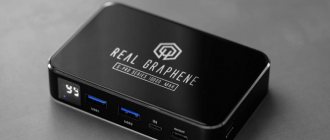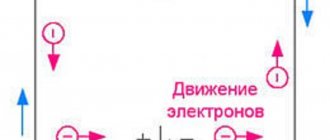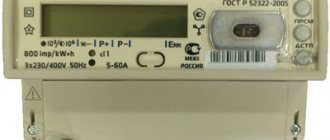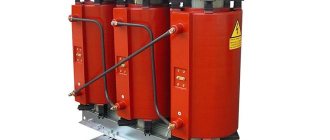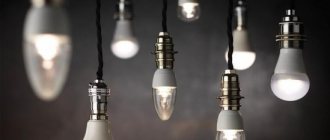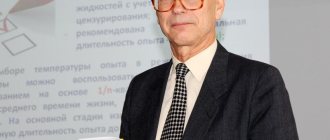Ionistors are electrochemical double-layer capacitors or supercapacitors. Their metal electrodes are coated with highly porous activated carbon, traditionally made from coconut shells, but most commonly from carbon airgel, other nanocarbons, or graphene nanotubes. Between these electrodes there is a porous separator, which holds the electrodes from each other, when wound on a spiral, the whole thing is impregnated with electrolyte. Some innovative forms of supercapacitor have a solid electrolyte. They replace traditional batteries in uninterruptible power supplies up to trucks, where they use a capacitor as a power source.
Principle of operation
The ionistor uses the action of a double layer formed at the interface between carbon and electrolyte. Activated carbon is used as an electrode in solid form, and electrolyte in liquid form. When these materials come into contact with each other, the positive and negative poles are distributed relative to each other over a very short distance. When an electric field is applied, an electric double layer is used as the main structure, which is formed near the surface of the coal in the electrolytic liquid.
Design advantage:
- Provides capacity in a small device, there is no need for special charging circuits to control during discharging in devices that use a supercapacitor.
- Overcharging or excessively frequent discharging does not negatively affect service life as with standard batteries.
- The technology is extremely “clean” from an environmental point of view.
- There are no problems with unstable contacts, as with conventional batteries.
Design disadvantages:
- The operating time is limited due to the use of electrolyte in devices that use an ionistor.
- Electrolyte may leak if the capacitor is not used correctly.
- Compared to aluminum capacitors, these ionistors have high resistance and therefore cannot be used in AC circuits.
Taking advantage of the advantages described above, electrical supercapacitors are widely used in applications such as:
- Memory reservation for timers, programs, e-mobile power, etc.
- Video and audio equipment.
- Backup sources when replacing batteries for portable electronic equipment.
- Power supplies for equipment using solar cells, such as clocks and indicators.
- Starters for small and mobile engines.
How to make an ionistor with your own hands
Making an ionistor yourself is an ineffective waste of time, but for the sake of experiment you can try. It requires two metal plates (usually copper) that fit tightly to a layer of activated carbon on both sides. The coal layer is divided in equal parts by a thin dielectric plate. All coal is impregnated with electrolytes.
The result of amateur activity - a large ionistor with your own hands
Wires are soldered onto the plates in advance so that there is something to charge through. When power is applied, an electrical double layer will begin to appear on the pores of the activated carbon. The “filling” is prepared simply: the coal is pounded into dust and mixed with an electrolytic composition until the consistency of a thick porridge is obtained. Subsequently, it is spread on degreased and cleaned plates.
You may be interested in this Connecting an electric motor
Redox reactions
The charge accumulator is located at the interface between the electrode and the electrolyte. During the charging process, electrons move from the negative electrode to the positive electrode along the outer circuit. During a discharge, electrons and ions move in the opposite direction. There is no charge transfer in an EDLC supercapacitor. In this type of supercapacitor, a redox reaction occurs at the electrode, generating charges and transferring charge through the double layers of the structure, where a supercapacitor is used.
Due to the redox reaction occurring in this type, there is a potential for lower power density than EDLC because Faradaic systems are slower than non-Faradaic systems. In general, pseudocapacitors provide higher specific capacitance and energy density than EDLCs due to their faradeite system. However, the correct choice of supercapacitor depends on the application and availability.
Varieties
Supercapacitors come in the following types:
- Pseudocapacitors are equipped with solid electrodes. Capacitance depends not only on electrostatic processes, but also on Faraday reactions with the movement of charges.
- Hybrids are a transition device between a battery and a capacitor. They are capable of accumulating and releasing charge in an electrical double layer. Electrodes are made of different materials, and the accumulation of charges occurs through different mechanisms. Redox reactions increase the specific capacity of the mechanism.
- Double-layer supercapacitors consist of porous electrodes separated by a separator. The electric charge in such devices is determined by the capacitance of the electrical double layer. The electrolyte is a connecting conductor with ionic conductivity.
Supercapacitors come in different shapes and sizes. The main purpose of such devices is to duplicate the main source in the event of a voltage drop.
To create hybrid devices, special types of cathodes are used. They are made from hyperoxidized graphene. Graphene is a two-dimensional modification of carbon in which the atoms are arranged in a single layer. This component is characterized by high chemical resistance.
Graphene-based materials
The supercapacitor has the ability to charge quickly, much faster than a traditional battery, but it is not able to store as much energy as a battery because it has a lower energy density. Increased efficiency is achieved through the use of graphene and carbon nanotubes. In the future, they will help ionistors completely replace electrochemical batteries. Nanotechnology is the source of many innovations today, especially in the e-mobile.
Graphene increases the capacity of ionistors. This revolutionary material consists of sheets whose thickness can be limited by the thickness of a carbon atom and whose atomic structure is ultra-dense. Such characteristics can replace silicon in electronics. A porous separator is placed between two electrodes. However, variations in the storage mechanism and the choice of electrode material lead to different classifications of high-capacity supercapacitors:
- Electrochemical double-layer capacitors (EDLC), which for the most part use high-carbon carbon electrodes and store their energy by rapidly adsorption of ions at the electrode/electrolyte interface.
- Psuedo capacitors are based on the phagadic process of charge transfer on or near the surface of an electrode. In this case, conducting polymers and transition metal oxides remain the electrochemical active materials, for example, as in battery-powered electronic watches.
Flexible polymer devices
The supercapacitor captures and stores energy at high rates by forming electrochemical double layers of charges or through surface redox reactions, resulting in high power densities with long cycle stability, low cost and environmental protection. PDMS and PET are the mainly used substrates in the implementation of flexible supercapacitors. In the case of film, PDMS can create flexible and transparent thin-film capacitors in hours with high cyclic stability after 10,000 flex cycles.
Single-walled carbon nanotubes can be further incorporated into the PDMS film to further improve mechanical, electronic, and thermal stability. Likewise, conductive materials such as graphene and CNTs are also coated with PET films to achieve both high flexibility and electrical conductivity. Besides PDMS and PET, other polymeric materials are also attracting growing interest and are synthesized by various methods. For example, localized pulsed laser irradiation has been used to rapidly transform a primary surface into an electrically conductive porous carbon structure with a defined graphic.
Natural polymers such as nonwovens made from wood fibers and paper can also be used as substrates that are flexible and lightweight. CNTs are deposited on paper to produce a flexible CNT paper electrode. Due to the high flexibility of the paper substrate and good distribution of CNTs, the specific capacitance and power and energy density change less than 5% after bending for 100 cycles at a bending radius of 4.5 mm. In addition, due to higher mechanical strength and better chemical stability, bacterial nanocellulose papers are also used to make flexible supercapacitors, such as the Walkman cassette player.
Supercapacitor Performance
It is defined in terms of electrochemical activity and chemical kinetic properties, namely: electron and ion kinetics (transport) within the electrodes and the efficiency of the rate of charge transfer to the electrode/electrolyte. Specific surface area, electrical conductivity, pore size and dissimilarity are important for high performance when using carbon-based materials with EDLC. Graphene, with its high electrical conductivity, large surface area and interlayer structure, is attractive for use in EDLC.
In the case of pseudocapacitors, although they provide superior capacitance compared to EDLC, they are still limited by the low power densities of the CMOS chip. This is due to poor electrical conductivity, which limits rapid electronic movement. In addition, the redox process that drives the charge/discharge process can damage electroactive materials. Graphene's high electrical conductivity and excellent mechanical strength make it suitable as a material in pseudocapacitors.
Studies of adsorption on graphene have shown that it occurs mainly on the surface of graphene sheets with access to large pores (i.e., the interlayer structure is porous, allowing easy access to electrolyte ions). Therefore, agglomeration of non-pore graphene should be avoided for better performance. Performance can be further improved by surface modification by attaching functional groups, hybridization with electrically conductive polymers, and by forming graphene/metal oxide composites.
Comparison of capacitors
Supercapacitors are ideal when fast charging is required to meet short-term power needs. The hybrid battery satisfies both needs and reduces voltage for longer life. The table below shows a comparison of the characteristics and main materials in capacitors.
| Electric double-layer capacitor, ionistor designation | Aluminum electrolytic capacitor | Ni-cd battery | Lead sealed battery | |
| Use temperature range | -25 to 70 °C | -55 to 125 °C | -20 to 60 °C | -40 to 60 °C |
| Electrodes | Activated carbon | Aluminum | (+) NiOOH (-) Cd | (+) PbO2 (-) Pb |
| Electrolytic fluid | Organic solvent | Organic solvent | KOH | H2SO4 |
| Electromotive force method | Using natural electrical double-layer effect as a dielectric | Using aluminum oxide as a dielectric | Using a chemical reaction | Using a chemical reaction |
| Pollution | No | No | CD | Pb |
| Number of charge/discharge cycles | >100,000 times | >100,000 times | 500 times | 200 to 1000 times |
| Capacity per unit volume | 1 | 1/1000 | 100 | 100 |
Charge characteristics
Charging time 1-10 seconds. The initial charge can be completed very quickly, but charging the top section will take additional time. It is necessary to consider limiting the inrush current when charging an empty supercapacitor, since it will draw all it can. The ionistor is not rechargeable and does not require full charge detection; current simply stops flowing when full. Performance comparison between car supercapacitor and Li-ion.
| Function | Ionistor | Lithium-ion (general) |
| Charging time | 1-10 seconds | 10-60 minutes |
| Life cycle of a watch | 1 million or 30,000 | 500 and above |
| Voltage | 2.3 to 2.75 V | 3.6 V |
| Specific energy (W/kg) | 5 (typical) | 120-240 |
| Power density (W/kg) | Up to 10000 | 1000-3000 |
| Cost per kWh | 10 000 $ | 250-1,000 $ |
| Life time | 10-15 years | From 5 to 10 years |
| Charging temperature | -40 to 65 °C | 0 to 45 °C |
| Discharge temperature | -40 to 65 °C | -20 to 60 °C |
Superionistor service life
The elements under consideration have quite long service lives. For example, at a rated voltage of 0.6 V, the device can operate for up to 40,000 hours. During all this time, only a slight decrease in capacity will be observed. The expected service life depends on that declared by the manufacturer, but the impact of humidity, high voltage and temperature changes on the ionistor should not be excluded.
Important! Typically, the timing is based on ideal laboratory conditions.
Device marking and polarity indication
Thus, in this material it was explained how to make an ionistor with your own hands, and where it found its application. These elements, invented relatively recently, were discussed as a source of alternative energy and a breakthrough, but they did not become one. Despite this, their scope is very wide.
Benefits of charging devices
Vehicles need that extra boost of energy to accelerate, and that's where supercapacitors come in handy. They have a limit on the total charge, but they are able to transfer it very quickly, making them ideal batteries. Their advantages over traditional batteries:
- Low impedance (ESR) increases surge current and load when connected in parallel to the battery.
- Very high cycle - discharge takes milliseconds to several minutes.
- Voltage drop compared to a battery-operated device without a supercapacitor.
- High efficiency at 97-98%, and DC-DC efficiency in both directions is 80%-95% in most applications, such as DVR with supercapacitors.
- In a hybrid electric vehicle, the circular driving efficiency is 10% greater than that of a battery.
- Works well over a very wide temperature range, usually from -40 C to + 70 C, but can also be from -50 C to + 85 C, there are special versions reaching 125 C.
- Small amount of heat generated during charging and discharging.
- Long cycle life with high reliability, reducing maintenance costs.
- Little degradation over hundreds of thousands of cycles and lasts up to 20 million cycles.
- They lose no more than 20% of their capacity after 10 years and have a lifespan of 20 years or more.
- Not subject to wear and aging.
- Does not affect deep discharges, unlike batteries.
- Increased safety compared to batteries - no risk of overcharging or explosion.
- There are no hazardous materials to dispose of at the end of use, unlike many batteries.
- Complies with environmental standards, so there is no difficult disposal or recycling.
Positive and negative sides
The undoubted advantages of these devices include the following qualities:
- discharging and charging the device does not take much time, which allows them to be used in cases where it is not possible to install batteries due to long recharging;
- Compared to rechargeable batteries, ionistors have significantly more complete charge-discharge cycles for the device;
- To recharge, you do not need special charging equipment, therefore, maintenance is simplified;
- radio components of this type are much lighter than batteries and smaller in size;
- wide operating temperature range – from -40 to 70C°;
- The service life is many times longer than that of power capacitors and batteries.
No matter how good these radio components are, they also have disadvantages that somewhat complicate operation, namely:
- The relatively high price of ionistors leads to the fact that their use in technology leads to an increase in its cost. According to experts, this problem will be solved in the near future thanks to the development of new technologies;
- low rated voltage parameters of devices, a solution can be a series connection of several elements (the principle is the same as when connecting several batteries). In this case, you will need to install a shunt in the form of a resistor on each component;
- Exceeding the temperature regime (heating more than 70C°) causes failure;
- This type of radio components does not allow one to accumulate enough energy; in addition, they have low energy density (that is, not as powerful as batteries), which somewhat narrows the scope of their application. Parallel connection of several elements allows us to partially cope with this problem.
Separately, it should be noted that supercapacitors are elements whose connection requires that polarity be observed. The device must not be short-circuited, as this will cause the temperature to rise and the radio element will need to be replaced.
Containment technology
The supercapacitor consists of two layers of graphene with an electrolyte layer in the middle. The film is strong, extremely thin and capable of releasing large amounts of energy in a short period of time, but nevertheless, there are certain as yet unresolved problems that are holding back technical progress in this direction. Disadvantages of an ionistor compared to rechargeable batteries:
- Low energy density - typically occupies 1/5 to 1/10 of the energy of an electrochemical battery.
- Linear Discharge - Failure to utilize the full energy spectrum; depending on the application, not all energy is available.
- As with batteries, cells are low voltage, requiring series connections and voltage balancing.
- Self-discharge is often higher than that of batteries.
- Voltage changes with stored energy - efficient storage and recovery of energy requires sophisticated electronic control and switching equipment.
- Has the highest dielectric absorption of all capacitor types.
- The upper use temperature is usually 70 C or less and rarely exceeds 85 C.
- Most contain a liquid electrolyte that reduces the size needed to prevent unintentional rapid discharge.
- High cost of electricity per watt.
Hybrid storage system
Special design and integrated power electronics technologies have been developed to produce supercapacitor modules with a new structure. Since their modules must be manufactured using new technologies, they can be integrated into car body panels such as the roof, doors and trunk lid. In addition, new energy balancing technologies have been invented that reduce energy losses and the size of energy balancing circuits in device and energy storage systems.
A series of related technologies have also been developed, such as charge and discharge control and connections to other energy storage systems. The 150F rated capacitance, 50V rated voltage capacitor module can be placed on flat and curved surfaces with a surface area of 0.5 sq. m and a thickness of 4 cm. The application is applicable to electric vehicles and can be integrated with various parts of the vehicle and other cases where energy storage systems are required.
What is an ionistor
Ionistors appeared on mass sale relatively recently. They may also be called supercapacitors or ultracapacitors. Outwardly, they are similar to ordinary condensing elements, which have a more impressive capacity. To put it simply, it is a mixture of a battery and a capacitor. The technical device of the device can be described as a condensing electrolytic element with a double electrical layer. In foreign literature it is usually referred to as EDLC, which stands for Electric Double Layer Capacitor.
Element appearance
For your information! A patent for the production of a device that stored electricity with a double electrical layer was received by the American K. Rightmyer back in the last century. Today, such elements have become extremely popular and are called ionistors.
Approximate structure diagram
Despite the fairly new technology for converting and storing electrical energy, such devices are today available for sale in almost any electrical and electronics stores, and their production is established not only abroad, but also in Russia.
Application and prospects
In the USA, Russia and China there are buses without traction batteries; all work is performed by ionistors. General Electric has developed a pickup truck with a supercapacitor that replaces the battery, similar to what has happened in some rockets, toys and power tools. Tests have shown that supercapacitors outperform lead-acid batteries in wind turbines, which was achieved without the energy density of supercapacitors approaching that of lead-acid batteries.
It is now clear that supercapacitors will kill lead-acid batteries over the next few years, but that is only part of the story as their performance improves faster than the competition. Suppliers such as Elbit Systems, Graphene Energy, Nanotech Instruments and Skeleton Technologies have claimed to exceed the energy density of lead-acid batteries with their supercapacitors and superbugs, some of which theoretically match the energy density of lithium-ions.
However, the supercapacitor in an electric vehicle is one aspect of electronics and electrical engineering that is ignored by the press, investors, potential suppliers and many people living on old technology, despite the rapid growth of a multi-billion dollar market. For example, for land, water and airborne vehicles, there are about 200 serious traction motor manufacturers and 110 serious traction battery suppliers, compared to just a few supercapacitor manufacturers. In general, there are no more than 66 large manufacturers of supercapacitors in the world, most of which have focused their production on lighter models for consumer electronics.
Practical use of ionistors
Modern models of supercapacitors have begun to be used in the fields of transport and consumer electronics.
Vehicles
Recently, powerful ionistors have increasingly been integrated into the power supply circuit of electric vehicles.
Heavy and public transport
Electric buses have begun to appear on the streets of megacities around the world. In Moscow you can see public transport powered by the energy of on-board ionistors. Domestic electric buses entered the capital’s city routes in May of this year.
On heavy vehicles, supercapacitors are used as an auxiliary power source.
Cars
Leading manufacturers of electric vehicles, such as Tesla and Nissan, taking advantage of international exhibitions, each time present new models whose power systems are built on ionistors. The Russian prototype Yo-mobile uses a supercapacitor as its main energy source.
Automotive ionistor
Additional Information. On vehicles running on liquid fuel, ionistors began to be installed to ensure easy engine starting in the Far North.
Supercapacitor with battery for easier engine starting
Auto racing
To promote and advertise cars powered by ionistors, leading automakers constantly hold auto races in such cars. Spectators at such events show great interest in the prospects for the development of electric personal transport.
Consumer electronics
Supercapacitors have exploded into the consumer electronics space. They can be seen in backup power supplies for laptops and smartphones. Ionistors are built into the operating units of personal computers. They protect against data loss during emergency outages from a constant source of electricity.
Ionistor for uninterruptible power supply of PC
